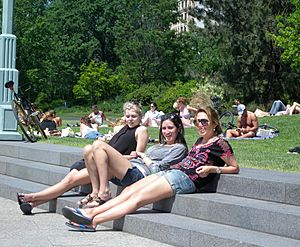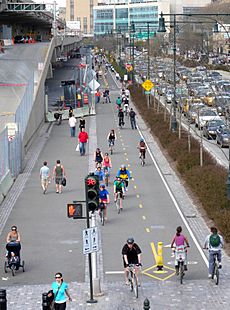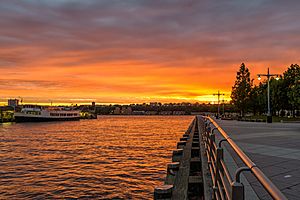Hudson River Park facts for kids
Quick facts for kids Hudson River Park |
|
|---|---|
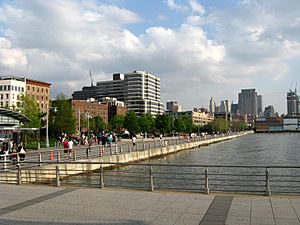
Greenwich Village section
|
|
| Type | Urban park Riverfront park Estuarine sanctuary |
| Location | Between Battery Place and West 59th Street West Side, Manhattan, New York City |
| Area | 550 acres (220 ha) |
| Operated by | State of New York City of New York Hudson River Park Trust |
| Visitors | 17 million (in 2015) |
| Status | Open |
| Hiking trails | 4 miles (6.4 km) |
Hudson River Park is a beautiful park along the Hudson River in Manhattan, New York City. It stretches for about 4.5 miles (7.2 km) from 59th Street down to Battery Park. This huge park covers 550 acres, making it the second-largest park in Manhattan, right after Central Park.
The park is a team effort between the State of New York and New York City. It's managed by a special group called the Hudson River Park Trust. The idea for the park came about in the late 1980s. This was after a big highway plan called "Westway" was canceled. The park was built in stages, starting in the 1990s and finishing mostly in the 2010s.
Hudson River Park connects many fun places and famous spots. It runs through neighborhoods like Lower Manhattan, Greenwich Village, Chelsea, and Midtown West. It also links up with other waterfront parks, like Riverside Park to the north and The Battery to the south.
The park has paths for biking and walking that go from one end to the other. This makes the waterfront a great place for outdoor activities. You can find tennis courts, soccer fields, batting cages, playgrounds, and dog runs here. Many old shipping piers along the river have also been rebuilt and are now part of the park.
Contents
How is Hudson River Park Managed?
The Hudson River Park Trust is the group in charge of designing, building, and running the park. It's a partnership between New York State and New York City. The Trust aims to be financially independent. This means it tries to earn money from things like rents from businesses in the park, fees, and donations. This money helps pay for staff and park upkeep.
Money for building new parts of the park usually comes from the state, the city, and federal funds. A board of thirteen people guides the Trust. There's also a large Advisory Council with fifty members who help with park planning.
A Look at the Park's History
How the Land Was Used Before
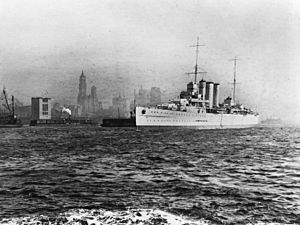
Long ago, before Europeans arrived, Native Americans lived seasonally on the shore of the Hudson River. They called a spot near today's Gansevoort Street "Sapohanikan." It was likely a place for hunting and fishing. They probably used the oyster beds along the shore too.
Later, after Europeans settled, oyster barges opened along the river. They sold huge amounts of oysters very cheaply. Many immigrants in New York City relied on oysters for food. But these oyster barges eventually closed. This happened because too many oysters were caught, and the water became polluted from industries.
In 1807, the first passenger steamboat, the Clermont, started its journey from what is now Pier 45. This successful boat helped Robert Fulton control steamboat travel on the Hudson River. Much later, famous ships like the Lusitania, the Olympic, and the Titanic used Pier 54 as a terminal. It was also where survivors of the Titanic sinking arrived on the ship Carpathia.
By the late 1800s, a "Slaughterhouse District" grew up along the river in Hell's Kitchen. Streets like 39th Street had tunnels for herding cattle under 12th Avenue. This cattle industry continued in the area until the 1960s.
How the Park Was Planned and Built
The idea for Hudson River Park came from a failed plan in the 1970s and 1980s called "Westway." This plan wanted to replace the old West Side Highway with a new interstate highway. The highway would have been built on 220 acres of new land created by filling in parts of the river.
The Westway plan also included ideas for 98 acres of parkland on top of the highway. But the project was stopped in 1985. This was because of concerns about its high cost and worries about how it would affect the Hudson River's striped bass fish. Most of the money set aside for Westway was then used for public transportation instead.
However, plans for a park still moved forward. By 1990, $265 million was secured for the park. The park would be built on all the land not used by the new surface-level West Side Highway, as well as on the remaining piers.
In 1992, a new plan was announced. It focused on using Piers 76, Chelsea Piers, and Pier 40 for businesses. The money from these businesses would help support the park. This plan also created the Hudson River Park Conservancy, which later became the Hudson River Park Trust.
Construction of the Chelsea Piers complex began in 1994. The law creating Hudson River Park was signed in 1998. It combined land owned by New York State and New York City. Both parts were then leased to the Hudson River Park Trust. The first complete section of the park opened in Greenwich Village in 2003.
After that, construction slowed down. Clinton Cove opened in 2005, and Piers 66 and 84 opened the next year. By 2009, half of the park was finished. As of 2015, about 70% of the park was complete, costing nearly $500 million.
Recent Years (2010s)
After Hurricane Sandy hit in October 2012, parts of Hudson River Park lost power. This was because electrical cables were damaged. The park had to limit its hours after dark. It took 20 months for full power to be restored in June 2014. The total damage from the storm was about $32 million.
By 2013, the Hudson River Park Trust was facing debt. A new law helped by saving money on park maintenance and insurance. It also allowed the park to charge fees for people boarding cruise ships from the park. The law also let the park sell "air rights" from land across the street. This means selling the right to build tall buildings above a certain height. This was especially important for Pier 40, which needed over $100 million for renovations.
In 2017, an agreement was made to finish the remaining 30% of the park.
In June 2018, New York State's first memorial to the LGBT community was placed in Hudson River Park near the Christopher Street Pier. The memorial has nine large rocks arranged in a circle. It honors the victims of the 2016 Orlando nightclub shooting.
What Can You Do at Hudson River Park?
Fun Activities and Sports
Hudson River Park offers many ways to have fun, whether you like organized sports, relaxing, or playing. A key feature is the 5-mile (8 km) bike and running path. It goes the whole length of the park, connecting to Riverside South in the north and Battery Park in the south. The Park Trust says it's "the busiest bikeway in America"!
You'll find many fields and courts throughout the park. Chelsea Waterside Park, for example, has a sports field, a basketball court, a playground with water features in summer, and a popular dog run. Pier 84 at West 44th Street is also full of activities. You can go fishing for free with Big City Fishing. You can also try free rowing and boat building at the Village Community Boathouse on Pier 40. Other water activities include outrigger rowing and kayaking at Pier 26.
The Water taxi stops at Pier 42. This pier also has a dog run and playground. Other sports facilities include basketball courts at Canal Street and Harrison Street. There are also tennis courts south of Pier 40, beach volleyball, and a California-style skate park at West 30th Street.
The biggest sports area in the park is the Chelsea Piers Sports and Entertainment Complex. It has lots of different athletic spaces. Chelsea Piers offers batting cages, bowling lanes, playing fields, a golf driving range, an ice skating rink, rock climbing, and gymnastics. Besides these indoor activities, Chelsea Piers also has boating and several restaurants.
Hudson River Park also lets you try outrigger canoeing at Pier 66. You can go rowing and sailing at Piers 40 and 66. Plus, there's free kayaking at Piers 96, 84, and 40. These free kayaking spots are run by local non-profits and volunteers. They are open five days a week, including weekends. It's a fun and affordable activity for everyone. You just need to sign a waiver and wear a life vest.
There are also many open grassy areas in the park for relaxing. Suntanning is a popular activity in places like Clinton Cove (55th Street), Pier 84 (44th Street), the 14th Street Park, and Pier 45. These are wide, open green spaces perfect for enjoying the sun.
Cool Structures and Piers
The park has many interesting spots along its path:
- Battery Park at the very south end.
- Battery Park City.
- The World Trade Center area.
- Brookfield Place and its Winter Garden.
- Chelsea Piers.
- Intrepid Sea-Air-Space Museum.
- Riverside Park at the very north end.
Famous Piers in the Park
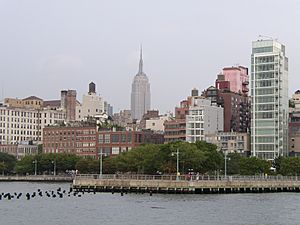
- Pier 25 is a sports and docking area at North Moore Street. It has the Mauro Memorial mini golf course.
- Pier 26 was rebuilt and a new park is set to open there in late 2020.
- Pier 34 is at Canal Street. It has two narrow walkways and a five-story building. This building is a ventilation shaft for the Holland Tunnel.
- Pier 40, at Houston Street, is home to the New York Knights rugby team. It also houses the main offices of the Hudson River Park Trust. This pier was built in 1962 for shipping. Now, it's mostly used for youth and amateur sports with various playing fields. It also has a parking lot. The Trapeze School of New York is here too. This pier brings in a lot of money for the park's yearly budget.
- The Christopher Street Pier usually means Pier 45, near West 10th Street in Greenwich Village. But it also refers to other piers between Piers 42 and 51. Pier 51 has a fun water-themed playground.
- Piers 52 and 53 used to be a sanitation facility. In 2019, plans were announced for a new 5.5-acre park here. It will include public art and Manhattan's first public beach! This park is expected to open in 2022. It will be the largest single green space in Hudson River Park.
- Pier 54 was shut down in 2011. Plans for a new park floating above the water were made in 2014. This project was stopped in 2017 due to high costs and lawsuits. But it was restarted later that year as part of a plan to finish the park.
- Pier 57, at 15th Street, used to be a shipping terminal. From 1969 to 2003, it was a bus depot. In 2004, it was used as a temporary holding area for people arrested during protests. New plans for the pier, called the SuperPier, are for commercial use.
- Piers 59–62 are known as Chelsea Piers. They were once a passenger ship terminal in the early 1900s. The RMS Lusitania used them, and the Titanic was supposed to arrive here. The Chelsea Piers Sports & Entertainment Complex opened here in 1995.
- Pier 63 was once a ferry terminal. Later, it housed a restaurant and historic ships like the lightship Frying Pan and the fire vessel John J. Harvey. In 2007, these ships moved to Pier 66.
- Pier 66 is at 26th Street and is used for sailing and paddle sports.
- Pier 79 is the West Midtown Ferry Terminal for NY Waterway. Pier 83 is used by Circle Line Sightseeing Cruises. Both companies helped rescue passengers from US Airways Flight 1549 when it landed in the Hudson River in 2009. Pier 79 also connects to an Art Deco style ventilation shaft for the Lincoln Tunnel.
- Pier 84 is at 44th Street. From 1981 to 1988, it was a concert venue. Famous bands like The Clash performed here. It opened as part of Hudson River Park in 2006 and is the largest public pier in the park. It has a water-themed playground, a New York Water Taxi stop, and a bike rental shop.
- Pier 86 at West 46th Street is home to the Intrepid Sea, Air & Space Museum. Its main attraction is the USS Intrepid, an aircraft carrier that served in World War II and the Vietnam War.
- Piers 88–92 are part of the New York Passenger Ship Terminal. Many modern cruise ships use them. In 1942, the USS Lafayette (formerly SS Normandie) caught fire at Pier 88. Pier 94 used to be part of the Passenger Ship Terminal. Now it houses the "Unconvention Center," a large exhibition hall.
- Pier 97 was once a passenger ship terminal. It was later demolished. Now, it's home to a live event venue called JBL.
Images for kids
See also
 In Spanish: Parque del Río Hudson para niños
In Spanish: Parque del Río Hudson para niños


